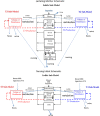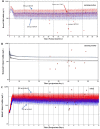Dietary Iodine Sufficiency and Moderate Insufficiency in the Lactating Mother and Nursing Infant: A Computational Perspective
- PMID: 26930410
- PMCID: PMC4773173
- DOI: 10.1371/journal.pone.0149300
Dietary Iodine Sufficiency and Moderate Insufficiency in the Lactating Mother and Nursing Infant: A Computational Perspective
Erratum in
-
Correction: Dietary Iodine Sufficiency and Moderate Insufficiency in the Lactating Mother and Nursing Infant: A Computational Perspective.PLoS One. 2016 May 3;11(5):e0155169. doi: 10.1371/journal.pone.0155169. eCollection 2016. PLoS One. 2016. PMID: 27136902 Free PMC article.
Abstract
The Institute of Medicine recommends that lactating women ingest 290 μg iodide/d and a nursing infant, less than two years of age, 110 μg/d. The World Health Organization, United Nations Children's Fund, and International Council for the Control of Iodine Deficiency Disorders recommend population maternal and infant urinary iodide concentrations ≥ 100 μg/L to ensure iodide sufficiency. For breast milk, researchers have proposed an iodide concentration range of 150-180 μg/L indicates iodide sufficiency for the mother and infant, however no national or international guidelines exist for breast milk iodine concentration. For the first time, a lactating woman and nursing infant biologically based model, from delivery to 90 days postpartum, was constructed to predict maternal and infant urinary iodide concentration, breast milk iodide concentration, the amount of iodide transferred in breast milk to the nursing infant each day and maternal and infant serum thyroid hormone kinetics. The maternal and infant models each consisted of three sub-models, iodide, thyroxine (T4), and triiodothyronine (T3). Using our model to simulate a maternal intake of 290 μg iodide/d, the average daily amount of iodide ingested by the nursing infant, after 4 days of life, gradually increased from 50 to 101 μg/day over 90 days postpartum. The predicted average lactating mother and infant urinary iodide concentrations were both in excess of 100 μg/L and the predicted average breast milk iodide concentration, 157 μg/L. The predicted serum thyroid hormones (T4, free T4 (fT4), and T3) in both the nursing infant and lactating mother were indicative of euthyroidism. The model was calibrated using serum thyroid hormone concentrations for lactating women from the United States and was successful in predicting serum T4 and fT4 levels (within a factor of two) for lactating women in other countries. T3 levels were adequately predicted. Infant serum thyroid hormone levels were adequately predicted for most data. For moderate iodide deficient conditions, where dietary iodide intake may range from 50 to 150 μg/d for the lactating mother, the model satisfactorily described the iodide measurements, although with some variation, in urine and breast milk. Predictions of serum thyroid hormones in moderately iodide deficient lactating women (50 μg/d) and nursing infants did not closely agree with mean reported serum thyroid hormone levels, however, predictions were usually within a factor of two. Excellent agreement between prediction and observation was obtained for a recent moderate iodide deficiency study in lactating women. Measurements included iodide levels in urine of infant and mother, iodide in breast milk, and serum thyroid hormone levels in infant and mother. A maternal iodide intake of 50 μg/d resulted in a predicted 29-32% reduction in serum T4 and fT4 in nursing infants, however the reduced serum levels of T4 and fT4 were within most of the published reference intervals for infant. This biologically based model is an important first step at integrating the rapid changes that occur in the thyroid system of the nursing newborn in order to predict adverse outcomes from exposure to thyroid acting chemicals, drugs, radioactive materials or iodine deficiency.
Conflict of interest statement
Figures







Similar articles
-
Dietary supplements for the lactating mother: influence on the trace element content of milk.Acta Paediatr Suppl. 1999 Aug;88(430):7-13. doi: 10.1111/j.1651-2227.1999.tb01294.x. Acta Paediatr Suppl. 1999. PMID: 10569217 Clinical Trial.
-
Environmental perchlorate and thiocyanate exposures and infant serum thyroid function.Thyroid. 2012 Sep;22(9):938-43. doi: 10.1089/thy.2012.0058. Epub 2012 Jul 24. Thyroid. 2012. PMID: 22827469 Free PMC article.
-
Interrelationship between iodine nutritional status of lactating mothers and their absolutely breast-fed infants in coastal districts of Gangetic West Bengal in India.Eur J Pediatr. 2018 Jan;177(1):39-45. doi: 10.1007/s00431-017-3025-6. Epub 2017 Oct 23. Eur J Pediatr. 2018. PMID: 29063209
-
Breastfeeding and maternal and infant iodine nutrition.Clin Endocrinol (Oxf). 2009 May;70(5):803-9. doi: 10.1111/j.1365-2265.2008.03442.x. Epub 2008 Oct 6. Clin Endocrinol (Oxf). 2009. PMID: 19178515 Review.
-
Breast-Milk Iodine Concentrations and Iodine Levels of Infants According to the Iodine Status of the Country of Residence: A Systematic Review and Meta-Analysis.Thyroid. 2018 Jan;28(1):124-138. doi: 10.1089/thy.2017.0403. Thyroid. 2018. PMID: 29334343
Cited by
-
Breast Milk Iodine Concentration (BMIC) as a Biomarker of Iodine Status in Lactating Women and Children <2 Years of Age: A Systematic Review.Nutrients. 2022 Apr 19;14(9):1691. doi: 10.3390/nu14091691. Nutrients. 2022. PMID: 35565659 Free PMC article.
-
Research needs for assessing iodine intake, iodine status, and the effects of maternal iodine supplementation.Am J Clin Nutr. 2016 Sep;104 Suppl 3(Suppl 3):941S-9S. doi: 10.3945/ajcn.116.134858. Epub 2016 Aug 17. Am J Clin Nutr. 2016. PMID: 27534640 Free PMC article. Review.
-
Maternal iodine status during lactation and infant weight and length in Henan Province, China.BMC Pregnancy Childbirth. 2017 Nov 16;17(1):383. doi: 10.1186/s12884-017-1569-0. BMC Pregnancy Childbirth. 2017. PMID: 29145827 Free PMC article.
-
Optimizing Growth: The Case for Iodine.Nutrients. 2023 Feb 5;15(4):814. doi: 10.3390/nu15040814. Nutrients. 2023. PMID: 36839172 Free PMC article. Review.
-
Iodine status of breastfed infants and their mothers' breast milk iodine concentration.Matern Child Nutr. 2020 Jul;16(3):e12993. doi: 10.1111/mcn.12993. Epub 2020 Mar 11. Matern Child Nutr. 2020. PMID: 32162412 Free PMC article.
References
-
- Berbel P, Mestre JL, Santamaria A, Palazon I, Franco A, Graells M, et al. Delayed neurobehavioral development in children born to pregnant women with mild hypothyroxinemia during the first month of gestation: the importance of early iodine supplementation. Thyroid. 2009;19(5):511–9. 10.1089/thy.2008.0341 - DOI - PubMed
-
- Henrichs J, Ghassabian A, Peeters RP, Tiemeier H. Maternal hypothyroxinemia and effects on cognitive functioning in childhood: how and why? Clin Endocrinol (Oxf). 2013;79(2):152–62. - PubMed
-
- Kooistra L, Crawford S, van Baar AL, Brouwers EP, Pop VJ. Neonatal effects of maternal hypothyroxinemia during early pregnancy. Pediatrics. 2006;117(1):161–7. - PubMed
-
- Li Y, Shan Z, Teng W, Yu X, Li Y, Fan C, et al. Abnormalities of maternal thyroid function during pregnancy affect neuropsychological development of their children at 25–30 months. Clin Endocrinol (Oxf). 2010;72(6):825–9. - PubMed
Publication types
MeSH terms
Substances
LinkOut - more resources
Full Text Sources
Other Literature Sources
Medical

